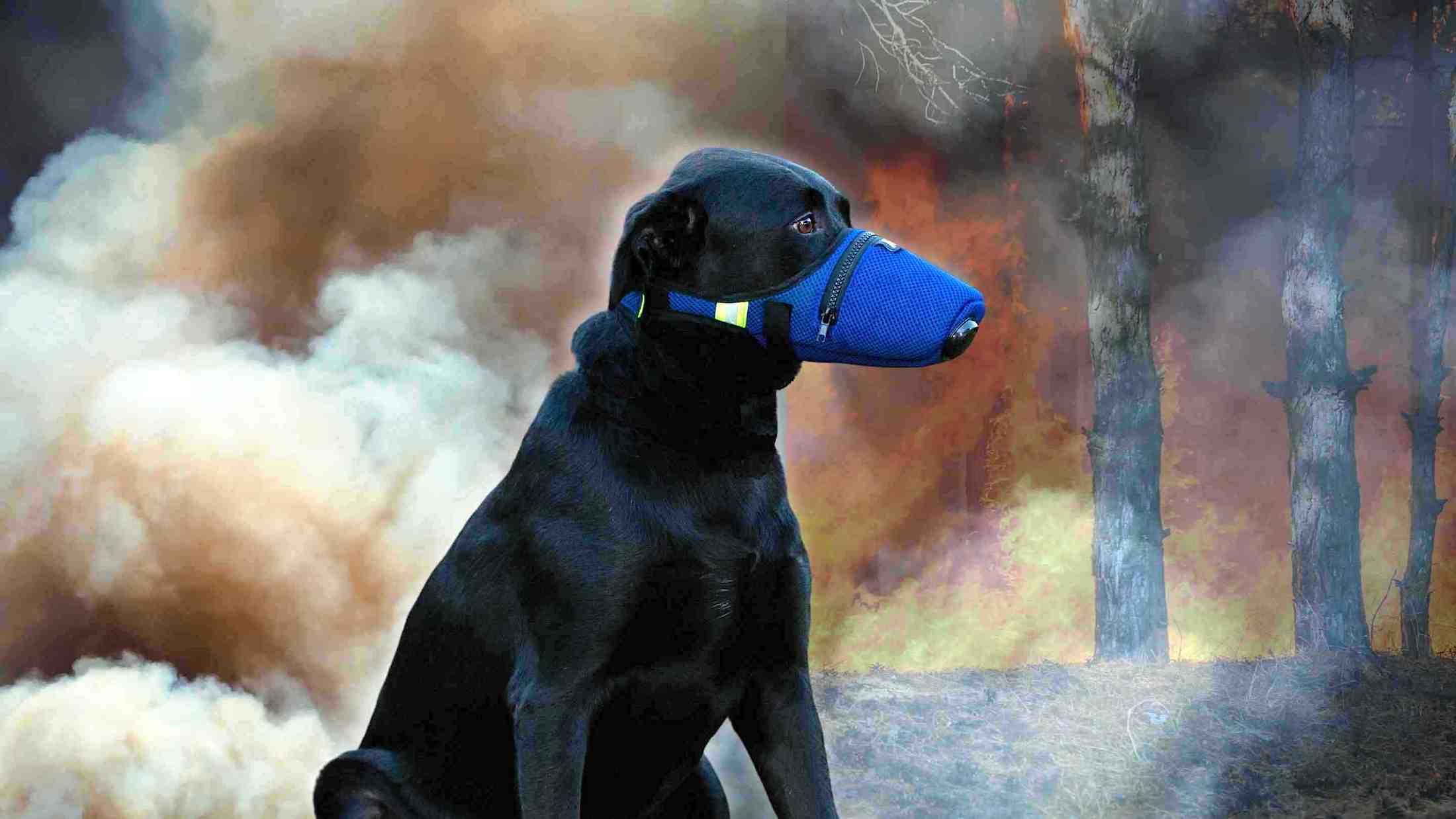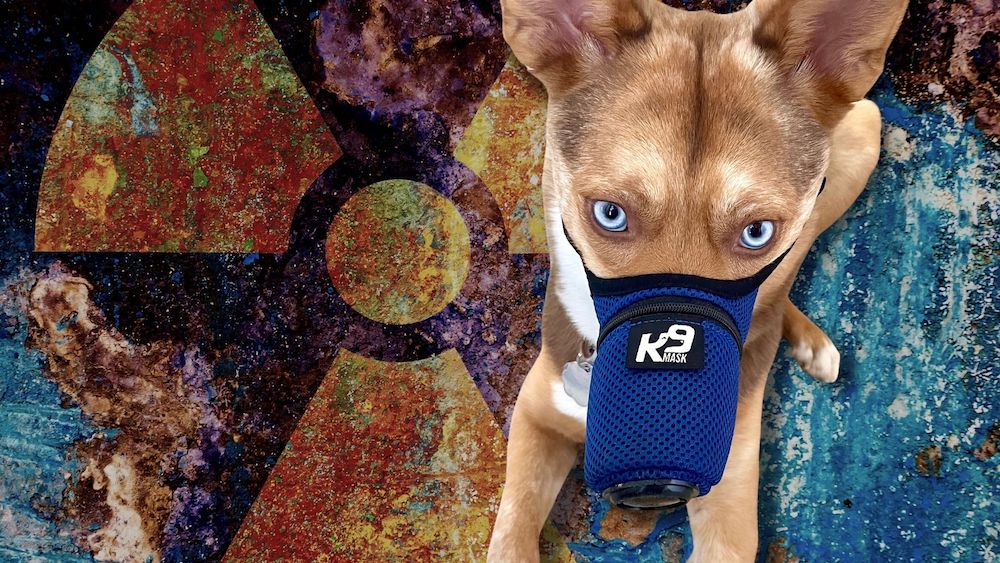Dogs were frequently used as laboratory subjects during the era of atomic bomb testing between 1950–1980, particularly in studies used to create data regarding the expected effects of accidental human occupational exposure to radiation.
Studies on the effects of ionizing radiation exposure in dogs were largely initiated to determine safety guidelines for humans working with radiation in the late 1940s and remain relevant to biologists today. The domestic dog was chosen for radiation research because of their larger body size and longer lifespan compared to rodents, as well as their widespread availability.
Frequent effects of radiation exposure in dogs include haematological changes, infertility, and cancer of the bone, liver, lung, and blood, among others. Effects depend on the radionuclide, method of exposure, age at exposure, dose rate, and total exposure dose.

The most likely route of exposure to radionuclides is believed to be inhalation, leading researchers to implement this mode of exposure in animal studies. Radon is a naturally occurring radionuclide that is frequently encountered in homes, and in humans is thought to be the second leading cause of lung cancer behind cigarette smoking.
Radon levels within homes vary depending on the local soil or rock and can even be emitted from building materials. Those who work with naturally occurring materials that are high in radon levels, such as uranium miners, are at particularly high risk for detrimental exposure. Early on, radon studies were conducted on humans at the Argonne National Laboratory, although these studies included a limited number of participants and did not focus on the physiological effects of radon exposure. Instead, researchers sought to differentiate between radon absorbed environmentally and radon that is produced in the body as a result of radium decay after exposure.

Several studies investigated the effects of radon inhalation exposure on dogs, reporting respiratory distress and respiratory tract tumors after exposure. In dogs exposed to radon, radon daughters, uranium ore dust, and/or cigarette smoke daily, pulmonary tumors were found after 50 months of exposure. Curiously, eight out of 19 dogs exposed to radon, radon daughters, and uranium ore dust daily developed respiratory tract tumors while only two out of 19 dogs exposed to radon, radon daughters, uranium ore dust, and cigarette smoke daily developed respiratory tract tumors. Researchers suggest that this could be related to increased mucus production or clearance as a result of cigarette smoking, causing a smaller radiation dose to bronchial and bronchiolar proliferating epithelial cells.
In 27 studies dogs were exposed to 239Pu, 238Pu, 144Ce, 90Sr, 90Y, 91Y, 241Am, Rn or U by inhaled aerosols containing radionuclides. Lung tumors and respiratory damage were common deleterious results and were unique to this method of exposure. Radiation pneumonitis, an inflammation of the lung caused by radiation exposure, was the predominant non-neoplastic disease observed.
After brief retention in the lungs, some radionuclides tend to translocate throughout the dog's body, causing varying effects related to deposition and protracted exposure. Translocation of radionuclides after initial exposure likely causes not only immediate but delayed effects as well, with chronic exposure producing a constant high dose to organs and tissues well after initial exposure.

For instance, a year after exposure to 238Pu, retention in the liver and skeleton of dogs remains persistent and is still present over 1000 days after exposure. By comparison, 239Pu clears from the lungs of exposed individuals with an average estimated half-time of 1192 days, and more than 10 years after exposure 65% of the overall final body burden was found in the thoracic lymph nodes. Delayed tumor formation occurs even without constant radionuclide exposure.
The leading cause of death reported in two separate studies of dogs exposed to single inhalations of 238Pu aerosols were bone tumors, followed by lung and liver tumors, all of which appeared approximately 3 years post-exposure. 144Ce similarly translocated to the liver and skeleton of exposed dogs, where the subsequent occurrence of liver and bone tumors were noted. Long-term retention of inhaled 90Sr was highest in the skeleton of exposed dogs leading to protracted exposure. As a result, 47% of exposed dogs suffered primary bone tumors.
What Do Studies Reveal about Dogs and Radiation?
Frequent effects of radiation exposure in dogs include hematological changes, infertility, and cancer of the bone, liver, lung, and blood, among others. Effects depend on the radionuclide, method of exposure, age at exposure, dose rate, and total exposure dose.
Can an N95 Mask Be Used to Protect from Radiation?
N95 Masks are designed to protect from things like smoke, ash, allergens, bacteria, and mold. The good news is they are capable to reducing inhalation of radioactive particles in the air. The protection, however, is limited because this is only one of the ways dogs absorb radioactive materials into their body. They also absorb it through the skin, eyes, and ingestion.

What is the Difference Between Alpha, Beta, and Gamma Radiation?
An air filter mask provides some protection from Alpha and Beta radiation. It DOES NOT protect you from Gamma radiation. Air filter mask are useful to prevent you from inhaling radioactive fallout following a nuclear detonation.
How Does a Gas Mask Protect Against Radiation?
The two types of radiation that would cause to wear an air filter mask are Alpha and Beta particles. Both of these types of radioactive particles are easily stopped by a gas mask.
Alpha radiation is a low energy particle that quickly loses energy as it travels from its source. It’s able to be stopped by a little more than an inch of air, a very small amount of water (.008″) and even unbroken skin.
The main problem posed by Alpha is caused when you inhale the materials emitting it. Your skin can stop the Alpha when it’s outside your body, but your internal organs aren’t able to do the same thing. This allows the Alpha particles to continuously radiate your body from the inside out once you’ve inhaled it.
Beta radiation is another relatively low energy particle. It’s stopped by 10′ of air, 2″ of water, a thin layer of metal or glass, and heavy clothing.
The dangers of Beta radiation are very similar to Alpha. When you inhale it, any external protection you may have is eliminated and you’re directly radiating your lungs and other organs.
An air filter mask will filter any contaminated solids from the air. It will also keep you from inhaling any Alpha or Beta particles. One of the overlooked benefits of a full-face respirator is that it keeps your eye protected from the same material!

Does an Air Filter Mask Protect from Gamma Radiation?
If you’re trying to protect yourself from Gamma radiation, then you’re going to have to do something other than wearing an air filter mask. It just doesn’t protect you from Gamma radiation.
Gamma radiation is a very high energy particle (similar to an x-ray) that needs significant shielding to be stopped. The thicker and denser material you can get behind the better. It takes almost 14″ of water, 6.6′ feet of concrete or 1.3′ of lead to stop Gamma radiation.
This means that the only way to keep Gamma from affecting you is to get as far away from the source as possible. If that isn’t possible then you need to get inside and put as much earth, concrete, and steel between you and the Gamma source as you can!

How Bad is Nuclear Radiation Fallout?
Nuclear fallout happens when a nuclear explosion happens close enough to the ground to throw earth and debris into the atmosphere. This happens in a lot of nuclear explosions but it’s worst during a surface or subsurface detonation.
Fallout close to the blast will start falling back to earth in around 30 minutes. Other fallout could stay suspended in the atmosphere for much longer until it’s brought back to earth by gravity and things like rain. By the time this happens, the fallout could have traveled a very long distance from the blast.
The fallout will contaminate everything that it lands on or in. This includes crops and water sources making it difficult to find food and water in areas that are in the fallout area.
How Does Radiation Damage the Body?
Alpha, Beta, and Gamma are all considered ionizing radiation. This is the type of radiation that weakens and breaks down DNA. This damage can either kill the cells or change them enough to make them mutate into cancer cells.
When cells are initially damaged by radiation, they cause what is known as radiation sickness. This is when the cells can’t replicate and start to die off. This causes swelling of the body, hair loss, and nausea. The cells that don’t die can mutate to the point where they start to reproduce out of control becoming cancer.
How Can I Limit Exposure to Radiation?
Should exposure to radioactive materials be of concern, the best ways to limit exposure from external sources of radiation are to:
- limit exposure time;
- increase distance from the radioactive material;
- block radiation using appropriate shielding.
Internal exposure to radioactive material may be reduced by:
- proper use of respiratory protection;
- monitoring food and water for contamination;
- using appropriate skin protection to prevent absorption and wound contamination.
Individuals and dogs can come into contact with radioactive materials through exposure to particulates, gases or vapors. When properly selected, fitted and used according to the manufacturer’s instructions, air filter masks can help reduce exposures to airborne contaminants, including particulates but will not eliminate all exposures. Further, air filter masks will not provide shielding against external sources of beta and gamma radiation.














